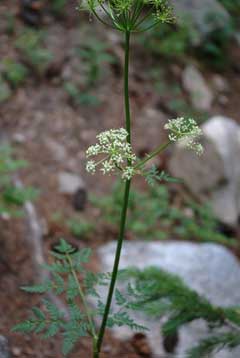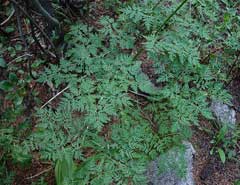 |
|
http://commons.wikimedia.org/wiki/User:JerryFriedman |
 |
| http://commons.wikimedia.org/wiki/User:JerryFriedman |
Translate this page:
Summary
Physical Characteristics

 Ligusticum porteri is a PERENNIAL growing to 0.9 m (3ft) by 0.6 m (2ft in).
Ligusticum porteri is a PERENNIAL growing to 0.9 m (3ft) by 0.6 m (2ft in).
See above for USDA hardiness. It is hardy to UK zone 6. The species is hermaphrodite (has both male and female organs) and is pollinated by Insects. The plant is self-fertile.
Suitable for: light (sandy), medium (loamy) and heavy (clay) soils and prefers well-drained soil. Suitable pH: mildly acid, neutral and basic (mildly alkaline) soils. It cannot grow in the shade. It prefers dry or moist soil.
UK Hardiness Map
US Hardiness Map
Synonyms
Plant Habitats
Cultivated Beds;
Edible Uses
Edible Parts:
Edible Uses: Condiment
The leaves are used as a flavouring, a celery substitute[155].
References More on Edible Uses
Medicinal Uses
Plants For A Future can not take any responsibility for any adverse effects from the use of plants. Always seek advice from a professional before using a plant medicinally.
Antirheumatic Antispasmodic Diaphoretic Diuretic Expectorant Febrifuge Kidney Stomachic
TB Uterine tonic
The roots, seed and essential oil (obtained from the roots and the seed) of this plant are a bitter, camphoraceous warming herb that stimulates the circulation, kidneys and uterus[238]. They are also antirheumatic, antispasmodic, diaphoretic, digestive, expectorant, febrifuge and stomachic[155, 172, 238]. They are used internally in the treatment of eruptive fevers, bronchial infections, digestive complaints, toothache, painful menstruation and retained placenta[238]. They have also been used to treat TB. and headaches[155, 172]. An infusion of the roots is used externally to treat body aches[257]. The root is harvested in the autumn and can be used fresh or dried[238].
References More on Medicinal Uses
The Bookshop: Edible Plant Books
Our Latest books on Perennial Plants For Food Forests and Permaculture Gardens in paperback or digital formats.

Edible Tropical Plants
Food Forest Plants for Hotter Conditions: 250+ Plants For Tropical Food Forests & Permaculture Gardens.
More

Edible Temperate Plants
Plants for Your Food Forest: 500 Plants for Temperate Food Forests & Permaculture Gardens.
More

More Books
PFAF have eight books available in paperback and digital formats. Browse the shop for more information.
Shop Now
Other Uses
References More on Other Uses
Cultivation details
Succeeds in any well-drained soil in a sunny position[200]. Succeeds in dry soils[238]. Plants are hardy to at least -15°c[238].
References Carbon Farming Information and Carbon Sequestration Information
Temperature Converter
Type a value in the Celsius field to convert the value to Fahrenheit:
Fahrenheit:
The PFAF Bookshop
Plants For A Future have a number of books available in paperback and digital form. Book titles include Edible Plants, Edible Perennials, Edible Trees,Edible Shrubs, Woodland Gardening, and Temperate Food Forest Plants. Our new book is Food Forest Plants For Hotter Conditions (Tropical and Sub-Tropical).
Shop Now
Plant Propagation
The seed is best sown as soon as it is ripe in a cold frame in the autumn. Stored seed should be sown as early in the year as possible in a greenhouse or cold frame[200]. Prick out the seedlings into individual pots when they are large enough to handle and plant them out into their permanent positions in the summer if they have grown large enough. Otherwise, keep them in a cold frame for the first winter and plant them out in early summer. Division in spring.
Other Names
If available other names are mentioned here
Native Range
NORTHERN AMERICA: United States (Colorado, Idaho (s.-c.), Wyoming (south), New Mexico, Arizona, Nevada (east), Utah), Mexico (Chihuahua, Nuevo León)
Weed Potential
Right plant wrong place. We are currently updating this section.
Please note that a plant may be invasive in one area but may not in your area so it's worth checking.
Conservation Status
IUCN Red List of Threatened Plants Status :

Growth: S = slow M = medium F = fast. Soil: L = light (sandy) M = medium H = heavy (clay). pH: A = acid N = neutral B = basic (alkaline). Shade: F = full shade S = semi-shade N = no shade. Moisture: D = dry M = Moist We = wet Wa = water.
Now available:
Food Forest Plants for Mediterranean Conditions
350+ Perennial Plants For Mediterranean and Drier Food Forests and Permaculture Gardens.
[Paperback and eBook]
This is the third in Plants For A Future's series of plant guides for food forests tailored to
specific climate zones. Following volumes on temperate and tropical ecosystems, this book focuses
on species suited to Mediterranean conditions—regions with hot, dry summers and cool, wet winters,
often facing the added challenge of climate change.
Read More
Expert comment
Author
J.M.Coult.&Rose.
Botanical References
155
Links / References
For a list of references used on this page please go here
Readers comment